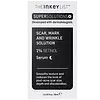What's inside
What's inside
 Key Ingredients
Key Ingredients

 Benefits
Benefits

 Concerns
Concerns

 Ingredients Side-by-side
Ingredients Side-by-side

Water
Skin ConditioningGlycerin
HumectantPrunus Armeniaca Kernel Oil
MaskingPersea Gratissima Oil
Skin ConditioningCaprylic/Capric Triglyceride
MaskingCetearyl Alcohol
EmollientGlyceryl Stearate Se
EmulsifyingSqualane
EmollientRetinol
Skin ConditioningPhenoxyethanol
PreservativeHydroxyethyl Acrylate/Sodium Acryloyldimethyl Taurate Copolymer
Emulsion StabilisingBenzyl Alcohol
PerfumingPhospholipids
Skin ConditioningTocopherol
AntioxidantPolyacrylate Crosspolymer-6
Emulsion StabilisingGlycine Soja Oil
EmollientEthylhexylglycerin
Skin ConditioningGlycolipids
Skin ConditioningDehydroacetic Acid
PreservativePolysorbate 60
EmulsifyingSorbitan Isostearate
EmulsifyingTrisodium Ethylenediamine Disuccinate
Glycine Soja Sterols
EmollientT-Butyl Alcohol
PerfumingWater, Glycerin, Prunus Armeniaca Kernel Oil, Persea Gratissima Oil, Caprylic/Capric Triglyceride, Cetearyl Alcohol, Glyceryl Stearate Se, Squalane, Retinol, Phenoxyethanol, Hydroxyethyl Acrylate/Sodium Acryloyldimethyl Taurate Copolymer, Benzyl Alcohol, Phospholipids, Tocopherol, Polyacrylate Crosspolymer-6, Glycine Soja Oil, Ethylhexylglycerin, Glycolipids, Dehydroacetic Acid, Polysorbate 60, Sorbitan Isostearate, Trisodium Ethylenediamine Disuccinate, Glycine Soja Sterols, T-Butyl Alcohol
Water
Skin ConditioningCaprylic/Capric Triglyceride
MaskingOctyldodecanol
EmollientCetearyl Alcohol
EmollientSorbitan Stearate
EmulsifyingGlycerin
HumectantCetyl Ethylhexanoate
EmollientGlyceryl Stearate
EmollientLactobacillus Ferment
Skin ConditioningRetinal
Skin ConditioningBakuchiol
AntimicrobialPersea Gratissima Oil
Skin ConditioningDaucus Carota Sativa Root Extract
Skin ConditioningPolyacrylate Crosspolymer-6
Emulsion StabilisingXanthan Gum
EmulsifyingCentella Asiatica Extract
CleansingSodium Phytate
Phenoxyethanol
PreservativeEthylhexylglycerin
Skin ConditioningCitrus Aurantium Dulcis Peel Oil
MaskingLavandula Angustifolia Oil
MaskingLitsea Cubeba Fruit Oil
MaskingRosmarinus Officinalis Leaf Oil
MaskingCananga Odorata Flower Oil
MaskingSalicylic Acid
MaskingWater, Caprylic/Capric Triglyceride, Octyldodecanol, Cetearyl Alcohol, Sorbitan Stearate, Glycerin, Cetyl Ethylhexanoate, Glyceryl Stearate, Lactobacillus Ferment, Retinal, Bakuchiol, Persea Gratissima Oil, Daucus Carota Sativa Root Extract, Polyacrylate Crosspolymer-6, Xanthan Gum, Centella Asiatica Extract, Sodium Phytate, Phenoxyethanol, Ethylhexylglycerin, Citrus Aurantium Dulcis Peel Oil, Lavandula Angustifolia Oil, Litsea Cubeba Fruit Oil, Rosmarinus Officinalis Leaf Oil, Cananga Odorata Flower Oil, Salicylic Acid
Ingredients Explained
These ingredients are found in both products.
Ingredients higher up in an ingredient list are typically present in a larger amount.
This ingredient is an emollient, solvent, and texture enhancer. It is considered a skin-softener by helping the skin prevent moisture loss.
It helps thicken a product's formula and makes it easier to spread by dissolving clumping compounds.
Caprylic Triglyceride is made by combining glycerin with coconut oil, forming a clear liquid.
While there is an assumption Caprylic Triglyceride can clog pores due to it being derived from coconut oil, there is no research supporting this.
Learn more about Caprylic/Capric TriglycerideCetearyl alcohol is a mixture of two fatty alcohols: cetyl alcohol and stearyl alcohol. It is mainly used as an emulsifier. Emulsifiers help prevent the separation of oils and products. Due to its composition, it can also be used to thicken a product or help create foam.
Cetearyl alcohol is an emollient. Emollients help soothe and hydrate the skin by trapping moisture.
Studies show Cetearyl alcohol is non-toxic and non-irritating. The FDA allows products labeled "alcohol-free" to have fatty alcohols.
This ingredient is usually derived from plant oils such as palm, vegetable, or coconut oils. There is debate on whether this ingredient will cause acne.
Due to the fatty acid base, this ingredient may not be Malassezia folliculitis safe.
Learn more about Cetearyl AlcoholEthylhexylglycerin (we can't pronounce this either) is commonly used as a preservative and skin softener. It is derived from glyceryl.
You might see Ethylhexylglycerin often paired with other preservatives such as phenoxyethanol. Ethylhexylglycerin has been found to increase the effectiveness of these other preservatives.
Glycerin is already naturally found in your skin. It helps moisturize and protect your skin.
A study from 2016 found glycerin to be more effective as a humectant than AHAs and hyaluronic acid.
As a humectant, it helps the skin stay hydrated by pulling moisture to your skin. The low molecular weight of glycerin allows it to pull moisture into the deeper layers of your skin.
Hydrated skin improves your skin barrier; Your skin barrier helps protect against irritants and bacteria.
Glycerin has also been found to have antimicrobial and antiviral properties. Due to these properties, glycerin is often used in wound and burn treatments.
In cosmetics, glycerin is usually derived from plants such as soybean or palm. However, it can also be sourced from animals, such as tallow or animal fat.
This ingredient is organic, colorless, odorless, and non-toxic.
Glycerin is the name for this ingredient in American English. British English uses Glycerol/Glycerine.
Learn more about GlycerinPersea Gratissima Oil is also known as avocado oil.
Avocado Oil has antioxidant properties. It is mostly made up of the glycerides of fatty acids. About 67% of these fatty acids is made up of oleic acid. Palmitic acid and linoleic acid are also present.
These fatty acids help hydrate and soften the skin. It may increase collagen content in the skin. Collagen helps keep your skin plump and firm. This ingredient helps reduce inflammation and has not shown to clog pores.
This ingredient may not be fungal-acne safe due to its high fatty acid content.
Avocados also have B vitamins, vitamin K, vitamin C, vitamin E, and potassium.
Learn more about Persea Gratissima OilPhenoxyethanol is a preservative that has germicide, antimicrobial, and aromatic properties. Studies show that phenoxyethanol can prevent microbial growth. By itself, it has a scent that is similar to that of a rose.
It's often used in formulations along with Caprylyl Glycol to preserve the shelf life of products.
Polyacrylate Crosspolymer-6 is a texture enhancer and pH adjuster.
It is be used to thicken water-based products and create a gel-texture with a velvet feel.
One manufacturer claims this ingredient to have a pH range of 2-8 and to be biodegradable.
Learn more about Polyacrylate Crosspolymer-6Water. It's the most common cosmetic ingredient of all. You'll usually see it at the top of ingredient lists, meaning that it makes up the largest part of the product.
So why is it so popular? Water most often acts as a solvent - this means that it helps dissolve other ingredients into the formulation.
You'll also recognize water as that liquid we all need to stay alive. If you see this, drink a glass of water. Stay hydrated!
Learn more about Water